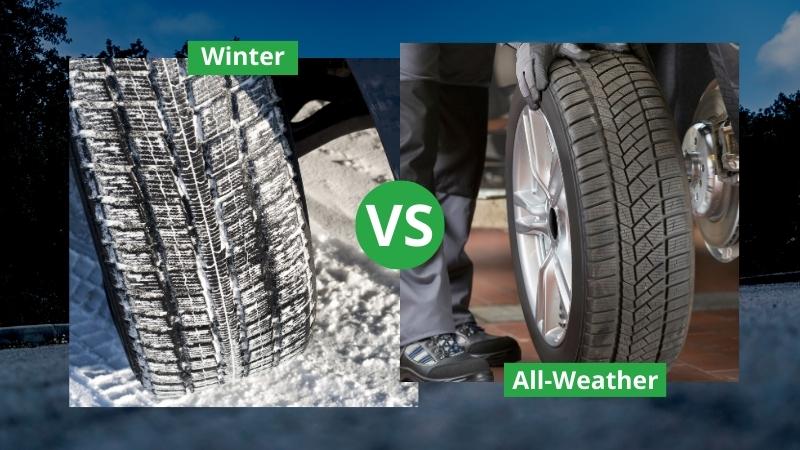When it comes to driving in various weather conditions, choosing the right tires for your vehicle is crucial. Two common tire types you may encounter are snow tires and all-weather tires.
Understanding the key differences between these tire choices allows you to make an informed decision that best suits your driving needs.
Snow tires, as the name suggests, are specifically designed to perform well in snowy and icy conditions. They have deeper tread depths and more detailed tread patterns compared to all-weather tires, which help provide better traction on snow and slush-covered roads.
On the other hand, all-weather tires are designed to offer a balance between performance in various weather conditions, including light snow, as well as dry and wet surfaces.
As you consider your tire options, keep in mind factors such as your driving habits, climate, and road conditions.
In the following sections, we’ll delve into the key differences between snow and all-weather tires, and discuss how to choose the right one for your specific needs.
Snow Tires Explained

Key Features
Snow tires, also known as winter tires, are specifically designed to provide better traction, handling, and braking in cold, snowy, and icy conditions. Some key features of snow tires include:
- A softer rubber compound that remains flexible in colder temperatures, improving grip on slippery surfaces.
- Deep, aggressive tread patterns that effectively disperse snow and slush while digging into the snow for better traction.
- Sipes, or small slits, in the tread blocks that increase the number of biting edges and provide extra grip on slippery surfaces.
- Mountain/Snowflake symbol, indicating that the tire meets the severe snow service rating and is suitable for winter driving conditions.
Benefits
Equipping your vehicle with snow tires has several advantages:
- Improved traction on snow and ice, minimizing the risk of skidding and losing control of your vehicle.
- Better braking performance in cold conditions, reducing the stopping distance on slippery surfaces.
- Increased driving confidence and overall safety during winter months.
- Reduced wear on your all-season or summer tires, prolonging their life and saving you money in the long run.
Drawbacks
Despite their benefits, there are some drawbacks to consider when choosing snow tires:
- Increased rolling resistance, which can lead to slightly higher fuel consumption.
- Softer rubber compounds can wear out more quickly on dry pavement, making them less cost-effective for year-round use.
- The need to purchase and store an additional set of tires, as well as the potential cost and inconvenience associated with seasonal tire changes.
- Handling and performance on dry roads may not be as optimal as with all-season or summer tires.
All-Weather Tires Explained

All-weather tires are designed to provide a balance between performance in various weather conditions, including wet road surfaces, light snow, and mild-to-moderate temperatures.
In this section, you will learn about the key features, benefits, and drawbacks of all-weather tires.
Key Features
All-weather tires have several characteristics that distinguish them from all-season and winter tires. These features include:
- Specialized rubber compounds for improved traction in both warm and cold temperatures, without sacrificing too much wear life. These compounds enable tires to stay flexible in colder conditions, providing better performance on snow and ice compared to all-season tires that can harden in cold temperatures.
- Aggressive tread patterns that channel water, slush, and snow away from the contact patch for enhanced grip on wet or snowy surfaces.
- A blend of characteristics from both all-season and winter tires, enabling all-weather tires to perform adequately in a wider range of conditions.
Benefits
There are several advantages of choosing all-weather tires for your vehicle:
- Year-round usability, which eliminates the need for separate sets of tires for different seasons, and saves on the costs of tire storage, mounting, and balancing.
- Better performance than all-season tires with just the M+S rating in colder temperatures and snowy conditions, thanks to rubber compounds that perform better in cool temperatures.
- Generally quieter and more comfortable ride compared to winter tires, as their tread design and rubber compound are closer to all-season tires.
Drawbacks
Despite the versatility of all-weather tires, they also have some limitations:
- They may not perform as well as dedicated winter tires in harsh winter conditions, especially in extremely low temperatures and heavy snowfall. Winter tires have specialized features that enhance traction, braking, and handling on icy and snowy roads.
- All-weather tires may wear slightly faster than all-season tires due to their more aggressive tread and softer rubber compound.
- In regions with moderate-to-hot climates, an all-season tire could provide better performance and longevity compared to an all-weather tire.
Comparing Winter and All-Weather Tires
Performance
Winter tires are specifically designed to provide optimal traction, handling, and braking on snow and ice-covered roads. They are made of softer rubber that remains flexible in freezing temperatures, allowing them to conform to the road and maintain grip when other tires might slip.
On the other hand, all-weather tires are a hybrid of all-season and winter tires, offering a balance between performance in various driving conditions. These tires can handle light snow, but may not be as effective as winter tires in extreme conditions.
Safety
Winter tires provide safety benefits when driving in snowy and icy conditions, as their better traction translates to quicker stopping times and improved handling in turns. In a test conducted by Popular Mechanics, winter tires improved braking performance by up to 5% and cornering performance by up to 20% compared to all-weather tires.
However, all-weather tires still have an edge over all-season tires when it comes to winter driving. By incorporating some of the winter tire technology, they perform better in wintry conditions than all-season tires.
Cost
Winter tires usually have a higher upfront cost compared to all-weather tires, but it’s important to consider the long-term value. Since you’ll only use winter tires during the colder months, they’ll last longer, potentially saving you money in the long run.
In addition, switching to winter tires during the appropriate season can prolong the life of your all-season or summer tires.
All-weather tires, on the other hand, can be a more cost-effective option if you live in an area with milder winters and less frequent snowfall. These tires are designed for year-round use, so you won’t need to swap them out as the seasons change.
They are a good choice if you want to save on tire-related expenses without sacrificing too much in terms of performance.
Choosing the Right Tire

Climate Considerations
When selecting the right tire for your vehicle, take into account the climate in your region. If you live in an area with frequent snowfall and harsh winter conditions, consider investing in winter/snow tires for better traction and handling on snow-covered roads.
These tires have a deeper tread depth that reduces snow accumulation and maintains grip better than all-season tires.
In milder climates with limited snowfall, all-season tires are a more suitable option. Designed to handle a range of weather conditions, they offer a balance of performance attributes, including for wet and dry roads.
Driving Habits
Your driving habits play a significant role in the decision-making process. If your daily commute consists of mainly highway or city driving, all-season tires may be sufficient for your needs. They provide a comfortable and quiet ride, as well as fuel efficiency.
However, if you often drive on snow or ice-covered roads, all-weather or winter tires offer improved braking and cornering performance due to their specialized tread patterns and rubber compounds, designed to perform in colder temperatures.
Budget
When choosing between snow and all-weather tires, it’s essential to consider your budget. All-weather tires might be more cost-effective long-term, as they can be used year-round, eliminating the need for tire swapping and storage.
However, if you live in an area with severe winter weather, the extra investment for a dedicated set of winter tires can significantly improve your driving safety and peace of mind.
Conclusion
In conclusion, understanding the key differences between snow and all-weather tires is crucial in making an informed choice for your vehicle. Snow tires offer better traction and stopping power in cold and snowy conditions, thanks to their deeper tread depth and specialized rubber compound.
On the other hand, all-weather tires provide a more versatile solution, as they perform well in both winter and milder weather conditions, without the need for tire changes each season.
Consider the climate and driving conditions in your area while making your choice. If you frequently encounter harsh winter conditions or heavy snowfall, snow tires may be the best option for you, as they outperform most all-season and all-terrain tires in cold and snowy conditions.
However, if you live in an area with milder seasons and occasional snow, all-weather tires could be a more suitable choice, offering many benefits without compromising much on performance.
Ultimately, prioritizing your specific needs and driving habits will lead you to the most appropriate tire choice. Remember to always consult a professional if you’re unsure about the right tire option for your vehicle.
By equipping your car with the most suitable tires, you will optimize your driving experience and ensure your safety on the road.
Hi, my name is Niklas, the head content creator & CEO of Whirling Wheelz. I am very interested in vehicles of all kinds, mainly cars. I have a car mechanics degree from high school and a big hobby of mine is to follow the WRC (World Rally Championship) both online and through travel.


